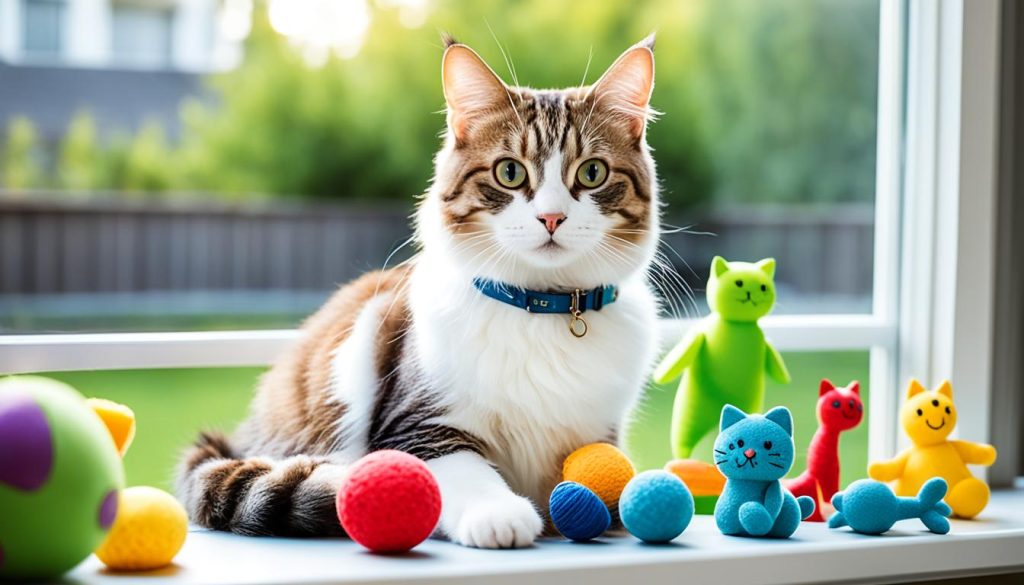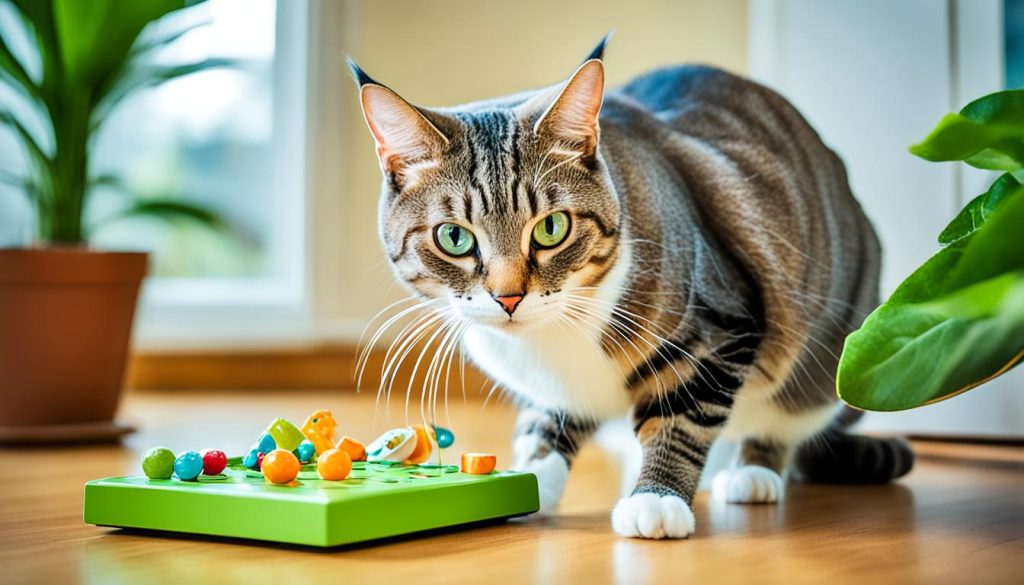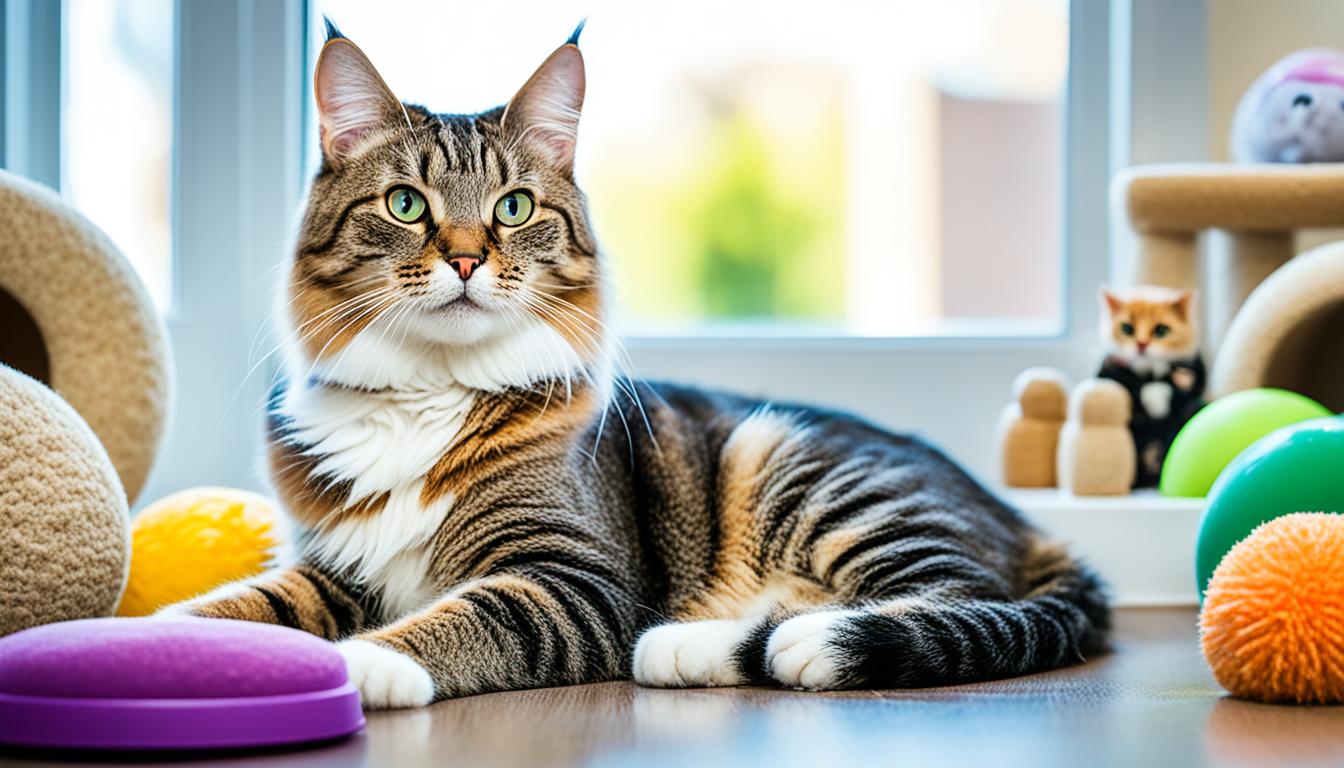Did you know that going outside is not a requirement for feline happiness? Contrary to popular belief, cats can lead fulfilling lives indoors, as long as their needs are met. By creating a stimulating environment filled with interactive play, mental stimulation, and environmental enrichment, you can keep your beloved cat safe and content indoors. Let’s explore some tips and tricks to ensure your furry friend thrives in an indoor setting.
Key Takeaways:
- Going outside is not necessary for a cat’s happiness.
- Interactive play and toys can satisfy a cat’s natural instincts.
- Catios and fenced yards provide a safe outdoor experience.
- Training your cat to walk on a leash allows for supervised outdoor adventures.
- Foraging opportunities during mealtime can engage your cat’s hunting instincts.
Start ’em young: Keeping kittens indoors
When it comes to indoor cat care, starting young is key. Kittens who are introduced to the indoor environment from an early age are more likely to adapt and be content staying inside as they grow up. By establishing their territory indoors, you can provide a safe and stimulating environment for your feline friend.
To keep kittens entertained and satisfied indoors, it’s important to provide them with plenty of toys, scratching posts, and interactive play. These enriching activities allow them to engage their natural instincts and provide mental and physical stimulation. A variety of toys such as feather wands, interactive puzzle toys, and catnip-infused plush mice can keep them entertained for hours.
Investing in high-quality scratching posts is also essential to fulfill their natural scratching needs. Place the scratching posts strategically around the house, near their favorite spots, to encourage appropriate behavior and prevent furniture damage.
Creating vertical spaces, such as cat trees or wall-mounted shelves, gives kittens opportunities to climb, jump, and observe their environment from different perspectives. These structures provide mental stimulation and allow them to retreat to a safe and elevated space whenever they desire.
Remember to spend quality playtime with your kittens to establish a strong bond and meet their social needs. Engaging in interactive play, such as using a wand toy, will keep them active and encourage exercise.
By starting ’em young and providing the right environment, toys, and interactive play, you can ensure that your kittens grow up happy and content as indoor cats.
Creating a safe outdoor experience: Catios and fenced yards
If you want to give your cat a taste of the outdoors while ensuring their safety, there are several cat containment ideas you can consider. One popular option is providing a screened porch or building a cat enclosure, also known as a catio. These enclosures allow your cat to experience the outside environment while preventing cat escape.
To cat-proof your yard and prevent any potential escapes, it’s essential to assess for possible escape routes and eliminate them. This could include filling in any gaps in fences or installing cat-specific barriers. Additionally, it’s important to remove any toxic plants or dangerous objects that could harm your cat.
By incorporating catios or creating a securely fenced outdoor area, you can give your cat the opportunity to enjoy the sights, sounds, and fresh air of the outdoors while providing peace of mind to keep them safe and prevent any escapes.

Cat Patio (Catio) Design Ideas
If you’re considering building a catio, here are some design ideas to make it a comfortable and stimulating space for your feline friend:
- Include perches and platforms at different heights to encourage climbing and provide vertical space.
- Add shelves or ramps for your cat to explore and move around easily.
- Provide hiding spots such as enclosed cubbies or tunnels for your cat to feel secure.
- Incorporate scratching posts and toys to keep them entertained and engage their natural instincts.
- Consider adding plants that are safe for cats, such as catnip or cat grass, to enhance their sensory experience.
By designing a catio that includes these elements, you can create a stimulating outdoor environment that enriches your cat’s life and prevents them from escaping. Remember to regularly inspect the catio for any potential hazards and provide plenty of fresh water and shade for your cat’s comfort.
| Catio Design | Description |
|---|---|
| Luxury Catio | A spacious and luxurious catio featuring multiple levels, built-in perches, and a cozy sheltered area. |
| Window Box Catio | A smaller catio that fits in front of a window, allowing your cat to enjoy the view while safe indoors. |
| Vertical Catio | A tall catio design that maximizes vertical space with climbing walls, shelves, and suspended toys. |
| Modular Catio | A customizable catio system that can be adapted and expanded to fit your available space and preferences. |
These are just a few examples of catio designs, and you can get creative with your own unique ideas. Remember to prioritize safety and provide a comfortable and stimulating environment that meets your cat’s needs.
Walking on a leash: Safe outdoor adventures
If you live in a peaceful neighborhood, you can train your cat to walk on a leash. Walking your cat on a leash can provide a safe outdoor adventure and allow them to explore their surroundings while staying under your supervision. It’s important to introduce leash training to your cat when they are young to help them become accustomed to it.
When starting leash training, choose a harness designed specifically for cats. A harness provides better control and reduces the risk of your cat slipping out of it. Make sure the harness fits snugly but not too tight, allowing your cat to move comfortably.
Begin the training process indoors, allowing your cat to become familiar with the harness and leash. Let them wear the harness for short periods while they are playing or eating to create positive associations. Offer treats and praise to reward them for wearing the harness.
Once your cat is comfortable with the harness, you can start taking them outside on a leash. Start with short walks in a quiet and secure area, such as your backyard or a local park. Keep the walks calm and relaxed, allowing your cat to explore their surroundings at their own pace.
Always supervise your cat while they are outside on a leash. Pay attention to their body language and be aware of any signs of stress or discomfort. If your cat becomes anxious or overwhelmed, take them back inside and try again another time. It’s important to prioritize your cat’s well-being and comfort during outdoor outings.
Walking your cat on a leash not only provides them with physical exercise but also mental stimulation. They can experience new sights, sounds, and smells while still being safe and protected. So grab the leash, put on the harness, and enjoy a safe outdoor adventure with your feline companion!
Engaging your cat’s natural hunting instincts: Mealtime activities
Cats have a natural hunting instinct, and it’s important to provide them with opportunities to engage in this behavior. One way to do this is by incorporating enrichment activities into their mealtime routine. By turning their feeding time into a stimulating experience, you can keep your indoor cat entertained and mentally engaged.
One simple way to engage your cat’s hunting instincts during mealtimes is to hide small amounts of food in various locations around your home. This encourages your cat to use their natural hunting skills to search and find their food, providing mental stimulation and physical exercise. You can start by hiding a few kibble pieces in easily accessible places and gradually increase the difficulty level as your cat becomes more adept at the game.
Another option is to use treat toys that mimic hunting scenarios. These toys are designed to dispense small amounts of food or treats when your cat interacts with them. There are a variety of interactive treat toys available, such as puzzle feeders and food-dispensing balls, that require your cat to use their paws or manipulate the toys to access the food inside. This not only engages their hunting instincts but also slows down their eating pace, promoting better digestion.
| Benefits of Mealtime Activities for Indoor Cats: |
|---|
| 1. Mental Stimulation |
| 2. Physical Exercise |
| 3. Mimics Natural Hunting Behavior |
| 4. Slows Down Eating Pace |
Engaging your cat’s natural hunting instincts during mealtimes is not only beneficial for their overall well-being but also helps to prevent boredom and destructive behavior. By incorporating these enrichment activities into your cat’s daily routine, you are providing them with the mental and physical stimulation they need to lead a happy and fulfilling life indoors.

Next Steps: Interactive Playtime and Environmental Enrichment
In the next section, we’ll explore the importance of interactive playtime and how to provide environmental enrichment for your indoor cat. These additional strategies will help keep your cat mentally stimulated, physically active, and contented.
Interactive playtime: Toys for hunting and exercise
When it comes to keeping your indoor cat happy and fulfilled, interactive playtime is essential. Engaging your cat in play not only provides physical exercise but also stimulates their natural hunting instincts. To ensure your cat gets the most out of playtime, it’s important to choose toys that mimic their prey and allow them to engage in stalking, chasing, catching, and biting.
There are a variety of toys available that can provide your cat with hours of entertainment and enrichment. Plush mice are a classic choice that cats love to pounce on and carry around. Feather toys are also great for mimicking birds and enticing your cat to engage in an active chase.
Interactive toys that can be pulled on a string are another excellent option for engaging your cat in dynamic play. These toys allow you to control the movement, replicating the unpredictable nature of prey, and providing a stimulating and exciting experience for your cat.
Remember to regularly rotate your cat’s toys to prevent boredom. Introducing new toys and hiding others for a while will keep your cat’s playtime fresh and engaging. By incorporating these interactive toys into your cat’s play routine, you’ll not only provide physical exercise but also mental stimulation, helping to keep your indoor cat happy and enriched.
| Toy | Description |
|---|---|
| Plush Mice | Realistic, small rodent-shaped toys that cats love to pounce on and carry around. |
| Feather Toys | Toys adorned with feathers to mimic birds and evoke your cat’s hunting instincts. |
| Interactive String Toys | Toys that can be pulled on a string, allowing you to simulate the unpredictable movement of prey. |
Providing environmental enrichment: Scratchers and vertical space
Cats are natural climbers and scratchers, and providing them with appropriate outlets for these behaviors is essential for their well-being. By giving cats the opportunity to engage in these natural activities, you can help reduce destructive behavior and promote a happy indoor environment.
Scratching is a vital behavior for cats as it helps them mark their territory, stretch their muscles, and keep their claws healthy. To satisfy their scratching instincts, provide your cat with a variety of scratchers made of sisal, rope, carpeting, or cardboard. These materials offer different textures and sensations, allowing your cat to find their preferred scratching surface.
Placing scratchers strategically around your home, especially near areas your cat frequents, can encourage them to use the scratchers instead of furniture or carpets. By redirecting their scratching behavior, you can protect your belongings and create a positive environment for your cat.
In addition to scratchers, vertical space is essential for cats to feel safe and secure. It allows them to observe their surroundings from a height, mimicking their natural instincts as hunters. Vertical space can be provided through the use of cat trees, perches, and shelves.
Cat trees come in various sizes and designs, providing platforms and hideaways for cats to explore. They often feature scratching posts, which combine vertical space and scratching opportunities in one piece of furniture. Perches and shelves can be installed on walls or windowsills, offering your cat elevated spots to rest, observe, and bask in the sunlight.
Not only does vertical space provide enrichment for your cat, but it also helps with multi-cat households by giving each cat a separate area to call their own. It promotes a sense of territorial security and reduces the likelihood of conflicts between cats.
Benefits of Scratchers and Vertical Space:
- Allows cats to engage in natural behaviors, such as scratching and climbing
- Reduces the likelihood of destructive behavior, such as furniture scratching
- Provides cats with a sense of territory and security
- Offers cats opportunities to observe their environment from a height
- Promotes physical exercise and mental stimulation
- Helps prevent conflicts in multi-cat households
| Scratchers | Vertical Space |
|---|---|
| Provides cats with appropriate surfaces for scratching | Allows cats to observe their surroundings from a height |
| Reduces furniture damage caused by scratching | Promotes a sense of territorial security |
| Offers different textures and sensations for variety | Provides separate areas for each cat in multi-cat households |
Meeting natural needs: Litter box setup and mental stimulation
When it comes to indoor cat care, providing for your cat’s natural needs is essential for their well-being. Two important aspects to consider are the litter box setup and mental stimulation. By ensuring these needs are met, you can create a comfortable and enriching environment for your furry friend.
First and foremost, the litter box setup is crucial. Make sure to have one litter tray per cat and place them in different locations throughout your home. This ensures that each cat has their own designated area and reduces the likelihood of accidents. Use unscented clay litter, as some cats are sensitive to strong fragrances. Regularly clean the litter trays to maintain a hygienic environment, as cats prefer cleanliness and may avoid a dirty litter box.
In addition to a clean and properly set up litter box, mental stimulation is key to preventing boredom and promoting a healthy cat behavior. Engage in training activities with your cat, such as teaching them tricks or using interactive toys. Puzzle feeders are another great way to stimulate their minds and make mealtime more engaging. It challenges their hunting instincts and provides mental stimulation while they work to access their food.
Lastly, create a variety of hiding spots and resting areas for your cat. Cats love to explore and have their own cozy spaces. Whether it’s a cat condo, a cozy bed, or even a cardboard box, these hiding spots provide a sense of security and comfort for your cat. Additionally, set up perches or shelves where they can observe their surroundings from a higher vantage point. This satisfies their need for vertical space and allows them to safely survey their territory.
